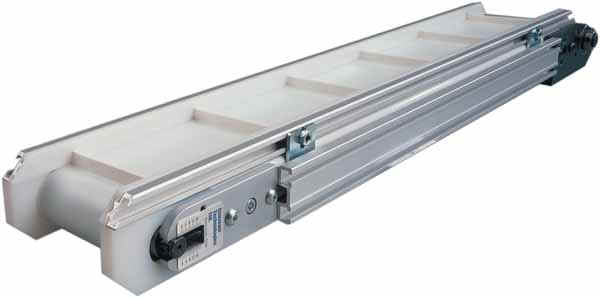

LOW PROFILE CONVEYORS
|
|
|
Flat Belt Tracking with Crowned Pulleys and Retainers
Steering of flat conveyor belts is most commonly and efficiently accomplished by utilizing “Crowned” pulleys. The crowned pulley utilizes a balance of opposing lateral forces to provide an automatic steering action, free from damaging abrasion. Tensioning adjustments on each side of the conveyor permit control of tension, as well as allow independent control of each side to bring these opposing lateral forces into balance for true center tracking. The use of crowned pulleys normally requires that the conveyor be capable of sustaining pre-tension belt elongation values of approximately .3% or greater. Tension values below this may result in inadequate lateral steering forces, as well as belt elongation, which can cause slippage of belt on pulley. In some extreme cases, (such as long conveyors) auxiliary adjustable angle steering rolls on the return side may be required for proper control. These rolls, like the crowned pulley, provide their steering action without inducing damaging wear or abrasion. When the belt is subjected to un-balanced or intermittent heavy lateral
loading, such as in product side loading or un-loading and diverting, it may be
necessary to consider the use of a “Retainer”. The retainer usually takes
the form of a “Vee Profile” attached to the bottom of the belt. The grooves
that contain this profile restrict the lateral belt movement much like the
“Guard Rail” on the highway restricts the vehicle, however, neither provides
any actual non-contact steering to the belt or vehicle. Belting authorities
state that the Vee Profile should not be the sole method of belt control, and
should only be subjected to lateral loading for brief periods. The reason for
this is that restricting lateral belt movement either in the slider bed or
pulley, can cause profile abrasion, as well as belt abrasion if pulleys are
knurled. For this reason, Conveyor Technologies Ltd.
does not normally recommend Vee retainers or knurled pulleys for food,
pharmaceutical, medical, or clean room applications. Also, because of
the angle of the Vee, a force results during restriction which tends to lift the
belt. If the run off forces are high enough, the restricting profile can run out
of its grooving causing the belt to run off the pulley. Some proponents of the
Vee profile caution the End-User that mis-tracking factors such as distorted
conveyor frame, improper or excessive side loading, and debris build-up on
pulley, can cause profile damage. Profiles increase belt cost, and lack any
non-wearing steering action, which can result in
reduced belt life caused by profile abrasion. Because of these
potential costs to the End User, CTL prefers to utilize the crowned pulley,
providing a “Proportional Automatic Steering Action”, and combine
this with the Vee profile only when conditions dictate its use. The following are statements taken directly from literature of several
leading belting manufactures and authorities: A)
“It is certain however, that guide profiles can counter a
run-off tendency only when it is weak. A conveyor belt which has a strong enough
run-off tendency cannot be prevented from running off by means of a guide
profile, since the profile climbs out of the groove in which it should run, and
continues to run off once it is on the drum.” B)
“In by far the majority of cases, the conveyor belt is guided by
cylindrical-conical drums.” C)
“Basic importance: longitudinal profiles can only absorb short
time lateral forces.” D)
“A misconception is that the V-guide “guides” the belt.” E)
“Guide profiles on the running side are above all suitable for
taking up transversal forces for brief periods of time.” F)
“The V-guide limits the lateral movement for short periods
only.” If no method of automatic tracking is utilized, the belt can become unstable and drift to one side. When this occurs damaging abrasion, and deformation of the belt edge can result. The magnitude of this is a function of belt tension, however, most Belt Manufactures caution against any form of belt edge restraint. TP1054E |
Send mail to WebMaster@ConveyorTechLtd.com with
questions or comments about this web site.
|